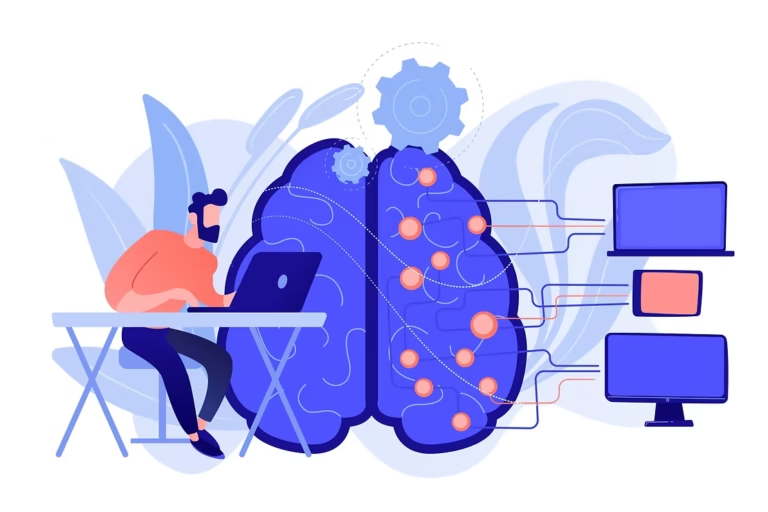As machine learning (ML) continues to be a game-changer across industries, mastering Python has become essential for anyone aspiring to work in this field. Top tech companies like Google, Facebook (Meta), Apple, Microsoft, Tesla, OpenAI, and NVIDIA look for candidates who have a deep understanding of Python’s capabilities in machine learning. This guide focuses on how to best use mastering Python for ML interviews.
This blog covers the essential Python libraries, techniques, and top interview questions you’ll encounter in ML interviews, with a special focus on the kinds of questions these tech giants are likely to ask.
Why Python is Essential for Machine Learning Interviews
Python’s simplicity, readability, and vast library support make it the go-to language for machine learning and data science. When interviewing for roles at top companies, proficiency in Python is a must, especially because it allows you to:
Develop ML models faster: Python’s rich libraries accelerate development time by offering pre-built functions for data manipulation, training, and deployment.
Focus on problem-solving: Python’s clean syntax allows engineers to focus on solving ML problems instead of getting bogged down by complex coding rules.
- Use powerful frameworks: Libraries like TensorFlow, PyTorch, and Scikit-learn make it easier to build, train, and scale ML models for various real-world applications.
Core Python Libraries for Machine Learning
Mastering these libraries can drastically improve your performance in interviews and your ability to develop machine learning solutions efficiently:
1. NumPy
What it does: NumPy (Numerical Python) is a library used for handling large, multi-dimensional arrays and matrices. It offers powerful mathematical functions for performing operations such as element-wise computations and broadcasting0.
Why it’s important: In machine learning, matrix manipulations and linear algebra are at the core of most algorithms, making NumPy an indispensable tool. It integrates seamlessly with TensorFlow, Scikit-learn, and other ML libraries.
2. Pandas
What it does: Pandas is a versatile library that allows you to manipulate, analyze, and clean data with ease. It introduces two primary data structures: Series (one-dimensional) and DataFrame (two-dimensional), which are used to store and manipulate data.
Why it’s important: Data preprocessing is often a significant part of ML workflows. Pandas makes it simple to clean, filter, and transform data, tasks commonly asked in interviews when candidates are required to prepare datasets before feeding them into models.
3. Scikit-learn
What it does: Scikit-learn is the go-to library for classical machine learning algorithms like linear regression, decision trees, support vector machines, and more. It also has tools for model evaluation, such as cross-validation.
Why it’s important: Scikit-learn’s ease of use and versatility make it the standard library for interview tasks involving supervised and unsupervised learning algorithms. You’ll often be asked to implement or tune models quickly using this library.
4. TensorFlow
What it does: TensorFlow is an open-source library developed by Google for building, training, and deploying deep learning models. It’s designed for scalable applications and can run on both CPUs and GPUs.
Why it’s important: TensorFlow is used in many real-world ML applications like image recognition and speech processing. For companies like Google and Apple, TensorFlow is a key part of their ML infrastructure, so familiarity with it is crucial in interviews.
5. PyTorch
What it does: PyTorch, developed by Facebook’s AI Research lab, is known for its flexibility and dynamic computation graph. It’s popular in academia and research.
Why it’s important: PyTorch allows you to prototype models quickly, which is essential in research and development roles. Companies like OpenAI and Tesla value candidates who can adapt quickly to PyTorch’s flexible nature.
Data Visualization Libraries
In ML, data visualization helps communicate findings effectively. These libraries will allow you to create informative visuals during interviews:
6. Matplotlib
What it does: Matplotlib is the standard library for creating 2D plots and graphs in Python. It is flexible but often requires more lines of code to generate complex plots.
Why it’s important: Matplotlib is commonly used to visualize datasets and model outputs. In interviews, being able to show insights via visualizations like histograms, scatter plots, and error charts can be a great way to demonstrate your understanding of the data.
7. Seaborn
What it does: Built on top of Matplotlib, Seaborn provides a simpler interface for creating more sophisticated and aesthetically pleasing plots. It’s especially useful for visualizing statistical relationships between data.
Why it’s important: Seaborn is useful for creating heatmaps, correlation matrices, and other visualizations that are often required in ML interviews to showcase data patterns and model performance.
Advanced Libraries and Techniques
Here are more advanced libraries that will give you an edge in interviews at top tech companies:
8. Keras
What it does: Keras is a high-level API for building deep learning models, running on top of TensorFlow. It’s designed to be easy to use and fast to implement.
Why it’s important: Keras simplifies complex neural network structures, allowing you to quickly build, test, and tune models during an interview.
9. XGBoost
What it does: XGBoost is a powerful implementation of the gradient boosting algorithm that is highly efficient and widely used in competitive ML.
Why it’s important: XGBoost is known for its superior performance, especially in classification and regression tasks, making it a frequently discussed topic in ML interviews at companies like NVIDIA and Tesla.
10. SciPy
What it does: SciPy builds on NumPy by adding modules for optimization, integration, interpolation, and other advanced mathematical operations.
Why it’s important: SciPy is useful when you’re asked to solve complex optimization problems in an ML interview, which often involves improving the performance of ML models.
Top 10 Python Interview Questions for ML Roles
Here are detailed explanations of 10 common Python questions you may face in interviews at companies like Google, Tesla, or Meta:
Explain the difference between deep copying and shallow copying in Python.
Answer: A shallow copy creates a new object but inserts references to the objects found in the original. If those objects are mutable (like lists), changes to them will affect both the original and the copied objects. A deep copy, however, creates a new object and recursively copies all objects found in the original, ensuring that changes in the copy do not affect the original object. This distinction is important when working with large datasets in ML to avoid unintended side effects.
What are Python decorators, and how would you use them in a machine learning project?
Answer: Decorators are a form of higher-order function that allow you to modify the behavior of a function or class method without changing its actual code. In machine learning projects, decorators can be used to log metrics, measure the execution time of a function, or apply caching to optimize repeated calculations. For example, you could use a decorator to log the time taken for each training epoch of a deep learning model.
How do you handle missing data using Pandas?
Answer: Pandas provides several methods for handling missing data. The dropna() function can be used to remove rows or columns with missing values, while fillna() allows you to fill in missing values with a specific value, such as the mean or median. Additionally, Pandas provides the interpolate() function to estimate missing values based on other data points in the series, which can be especially useful in time-series data.
What is the Global Interpreter Lock (GIL) in Python, and how does it affect multi-threading?
Answer: The Global Interpreter Lock (GIL) is a mechanism in CPython that ensures only one thread executes Python bytecode at a time. This can hinder the performance of multi-threaded Python programs, particularly in CPU-bound operations. However, multi-processing or using libraries like TensorFlow and PyTorch, which offload tasks to GPUs or use optimized C extensions, can overcome these limitations in machine learning tasks.
How would you optimize a Python-based machine learning pipeline for speed?
Answer: To optimize a Python ML pipeline, you can:
Utilize compiled libraries like NumPy or Cython to speed up numerical computations.
Profile your code using cProfile or line_profiler to identify bottlenecks.
Use parallel processing with multiprocessing or leverage GPU acceleration using TensorFlow or PyTorch.
Use memory-efficient data structures and avoid unnecessary copies of large datasets.
What is the difference between lists and tuples in Python?
Answer: Lists in Python are mutable, meaning they can be modified after creation, while tuples are immutable, which means once they are created, they cannot be changed. Lists are typically used when you need an ordered collection of items that may change during the course of an algorithm. Tuples are more efficient for fixed collections of items and can be used as keys in dictionaries.
Explain the difference between map(), filter(), and reduce() in Python.
Answer:
map(): Applies a function to every item in an iterable (e.g., a list) and returns a map object (an iterator).
filter(): Filters items in an iterable by applying a function that returns True or False for each item.
reduce(): Applies a function cumulatively to the items of an iterable, reducing the iterable to a single value.
Expanded Interview Questions
Explain the difference between map(), filter(), and reduce() in Python.
Answer:
map(): This function applies a specified function to each item of an iterable (such as a list) and returns a map object. The map object can be converted back to a list if needed. For instance, map(lambda x: x**2, [1, 2, 3, 4]) would return [1, 4, 9, 16].
filter(): It applies a function to each item and filters out items that return False. For example, filter(lambda x: x > 2, [1, 2, 3, 4]) would return [3, 4].
reduce(): Found in the functools library, it applies a function cumulatively to the items of an iterable, reducing them to a single value. For example, reduce(lambda x, y: x + y, [1, 2, 3, 4]) would return 10. It’s often used in scenarios where you need to reduce a collection of data to a single outcome.
How do you use the apply() function in Pandas, and why is it useful?
Answer: apply() is a powerful Pandas function used to apply a custom function across either rows or columns of a DataFrame. For example, if you want to apply a lambda function to square each value in a column, you could use df['column'].apply(lambda x: x**2). This is particularly useful in feature engineering for ML tasks when you need to create new features by transforming existing ones.
What is the difference between supervised and unsupervised learning?
Answer:
Supervised Learning: In supervised learning, the model is trained on labeled data, meaning the input data is paired with the correct output. Common algorithms include linear regression, logistic regression, and support vector machines (SVM). This is useful in scenarios like spam detection, where the model is trained to classify emails as spam or not, based on labeled examples.
Unsupervised Learning: Here, the model works with unlabeled data and tries to find patterns or clusters in the data. Algorithms like k-means clustering and principal component analysis (PCA) are commonly used. A typical use case is customer segmentation, where groups are discovered based on buying behavior without predefined labels.
How does Python handle memory management, and how does it affect machine learning projects?
Answer: Python’s memory management is handled by a built-in garbage collector that automatically deallocates unused objects to free memory. Python uses reference counting to track objects and a garbage collector to handle cyclic references. This affects ML projects when working with large datasets, where managing memory efficiently becomes crucial. You can optimize memory use in Python ML projects by:
Using generators to load data lazily.
Profiling memory with tools like memory_profiler to identify memory bottlenecks.
Utilizing specialized libraries like Numba or Cython to optimize performance.
Additional Sections for the Blog
Key Python Tools for Interview Preparation
In addition to libraries and techniques, Python developers should be familiar with key tools that enhance their ML workflows and interview performance:
Jupyter Notebooks:
Jupyter is widely used for developing and testing ML models because it allows you to run Python code in interactive cells and visualize outputs. It’s also a great tool for explaining your thought process during an interview, as you can walk interviewers through your code, showing plots, outputs, and markdown notes.
Git and Version Control:
Knowing how to use Git for version control is critical when working in collaborative environments, which is often a requirement in top tech companies. Git also allows you to manage different versions of your models or experiments.
Docker:
Docker is essential for containerizing ML models, making them easier to deploy and scale. Interviews may include discussions about deploying ML models in production, and familiarity with Docker will show your readiness for real-world environments.
Python Code Optimization Techniques for Machine Learning
When preparing for ML interviews, you’ll often be asked about code optimization. Here are key techniques to ensure your Python code runs efficiently:
Vectorization: Instead of using Python loops to manipulate arrays, use NumPy's vectorized operations, which are implemented in C for better performance.
Avoiding Duplicates in Memory: Use in-place operations whenever possible to avoid duplicating large datasets in memory.
Multiprocessing and Threading: If your ML task involves data preprocessing that can be parallelized, you can use Python’s multiprocessing module or libraries like joblib to distribute the workload across multiple cores【9†source】.
Profiling Tools: Use profiling tools like cProfile, timeit, or memory_profiler to identify performance bottlenecks in your code, such as slow functions or excessive memory usage.
Mastering Python for machine learning interviews involves more than just knowing the language’s syntax. By understanding the essential libraries, being comfortable with visualization tools, and preparing for commonly asked interview questions, you can significantly improve your chances of landing a role at top companies like Google, Tesla, and NVIDIA.
Python’s rich ecosystem of tools enables faster, more efficient model development. However, interviewers also expect you to know how to optimize your code, visualize data, and efficiently handle large datasets. By studying the questions and techniques outlined in this blog, you’ll be well-prepared to tackle the challenges of a machine learning interview and demonstrate the practical skills required for success in the industry.
Ready to take the next step? Join the free webinar and get started on your path to an ML engineer.






